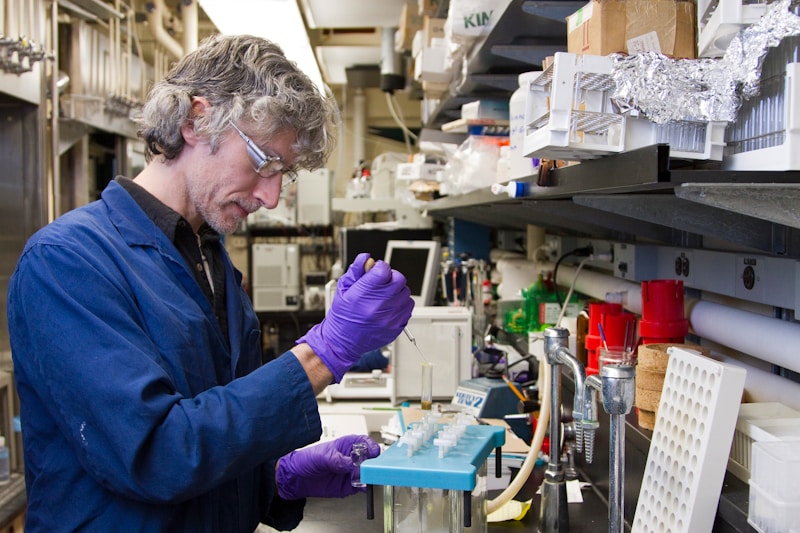20 Questions
What is the approximate percentage of ribosomal RNA (rRNA) that makes up a ribosome?
60%
Who proposed the term 'ribosome' in 1958?
RB Roberts
What is the unit of measurement for the rate of sedimentation in centrifugation?
Svedberg (S)
What is the name of the Nobel laureate who discovered ribosomes using an electron microscope?
George Palade
What is the size of the small subunit of the 70S ribosome?
30S
What is the size of the ribosomes found in eukaryotic cells?
80S
What is the role of ribosomal RNAs in protein synthesis?
They provide the structural core of each ribosomal subunit
Where does ribosome biogenesis take place in eukaryotic cells?
Both in the cytoplasm and in the nucleolus
What is the precursor RNA molecule formed by the transcription of r-RNA genes?
45S r-RNA complex
Where are the genes for 5S r-RNA located?
On chromosome 1
What is the role of ribosomal proteins in protein synthesis?
They assemble the small subunits with 18S rRNA
What happens to the two subunits of the ribosome during protein synthesis?
They are transferred to the cytoplasm when protein synthesis occurs
What is the function of the peptidyl-site (P site) in a ribosome?
It holds the t-RNA molecule linked to the growing end of the polypeptide chain
Which of the following types of proteins are usually synthesized by attached ribosomes to the membranes of GER?
Secretory proteins and lysosomal enzymes
What happens to the ribosomal subunits at the end of each round of protein synthesis?
They are released and rejoin the common pool in the cytosol
What is the term for a group of ribosomes connected by a strand of m-RNA during translation?
Polysomes
How many ribosomes can be found on a single m-RNA molecule during the translation of a protein like myosin?
100 ribosomes
Where are free ribosomes mainly found?
Oocytes, embryonic cells, and keratinocytes
How many ribosomes does a rapidly growing mammalian cell contain?
10 million ribosomes
What is the term for the site on a ribosome that holds the deacylated t-RNA molecule?
Exit site (E site)
Study Notes
Ribosomes
- Ribosomes are non-membranous organelles found in the cytoplasm of all living cells, responsible for protein synthesis.
- They are small electron-dense particles, 15-25nm in diameter, and can be free or membrane-bound (attached to the GER).
Discovery of Ribosomes
- Ribosomes were first observed in the mid-1950s by cell biologist George Palade using an electron microscope.
- In 1958, RB Roberts proposed the term "ribosome" instead of "ribonucleoprotein particles of the microsome fraction".
- George Palade was awarded the Nobel Prize in Medicine in 1974 for the discovery of ribosomes.
- The Nobel Prize in Chemistry 2009 was awarded to V Ramakrishnan, TA Steitz, and AE Yonath for their studies on the structure and function of the ribosome.
Composition of Ribosomes
- Ribosomes are composed of approximately 60% ribosomal RNA (rRNA) and 40% protein.
- They have two different subunits: the small subunit and the large subunit, which join together to produce a protein in the cytoplasm.
Classes of Ribosomes
- There are two classes of ribosomes: 70S ribosomes found in prokaryotic organisms (bacteria) and eukaryotic cell's organelles (mitochondria and chloroplasts), and 80S ribosomes found in eukaryotic cells.
- Both classes have nearly the same structure and function, but differ in size.
Ribosome Function
- Ribosomal RNA molecules and proteins catalyze many reactions during protein synthesis.
- RNA structures interact with tRNA, mRNA, and proteins during protein synthesis.
- Ribosomal RNAs provide the structural core of each ribosomal subunit.
Ribosome Biogenesis
- Ribosome biogenesis is the process of ribosome making, which takes place in the cytoplasm with the transcription of many ribosomal genes in prokaryotic cells.
- In eukaryotes, ribosome biogenesis occurs in both the cell cytoplasm and the nucleolus.
Functional Sites on the Ribosome
- There are four functional sites on the ribosome: the aminoacyl site (A site), the peptidyl site (P site), the exit site (E site), and the mRNA-binding site.
Types of Ribosomes
- Free ribosomes usually make proteins that function in the cytosol or are targeted to particular organelles.
- Attached ribosomes to the membranes of GER usually make proteins that are exported or included in the cell's membranes.
- A common pool of ribosomes is used to synthesize proteins that stay in the cytosol and those that are transported into the ER.
Polysomes
- In cell cytoplasm, free ribosomes are found as individual granules or in clusters called polysomes or polyribosomes.
- Polysomes consist of a group of ribosomes connected by a strand of mRNA during translation.
- More than one ribosome can be found on mRNA as coding sequences, which are longer than the 40 to 50 nucleotides associated with a ribosome.
- Usually, one mRNA runs successively through several ribosomes in a cluster, producing multiple copies of a protein.
Learn about ribosomes, non-membranous organelles in living cells, responsible for protein synthesis. Discover their structure, function, and history of discovery.
Make Your Own Quizzes and Flashcards
Convert your notes into interactive study material.
Get started for free



